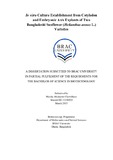| dc.contributor.advisor | Islam, Aparna | |
| dc.contributor.author | Chowdhury, Maisha Mosharrat | |
| dc.date.accessioned | 2015-05-12T06:29:25Z | |
| dc.date.available | 2015-05-12T06:29:25Z | |
| dc.date.copyright | 2015 | |
| dc.date.issued | 2015-03 | |
| dc.identifier.other | ID 11136010 | |
| dc.identifier.uri | http://hdl.handle.net/10361/4129 | |
| dc.description | This thesis report is submitted in partial fulfillment of the requirement for the degree of Bachelor of Science in Biotechnology, 2015. | en_US |
| dc.description | Cataloged from PDF version of thesis. | |
| dc.description | Includes bibliographical references (page 48 - 51). | |
| dc.description.abstract | Sunflower is considered as source of cholesterol free edible oil. Because of cross
pollinating nature of this plant, it is difficult to identify true breeding homozygous
line, thus, breeding becomes intricate. Besides, due to biotic and abiotic stresses,
development of this crop is urgent. This study was aimed to develop a potential
alternative to improve qualitative and quantitative production of this crop through
basic tissue culture regeneration. Several attempts with various explants have already
discovered in past but no initiative was reported for Bangladeshi sunflower varieties.
In present study, optimum seed sterilization method; the efficiency of different
explants; effect of different growth hormones in different combinations and
concentrations and rooting efficiency of initiated shoots were demonstrated for two
farmer popular Bangladeshi sunflower varieties, namely BARI Surjomukhi 2 and
BRAC Hysun 33. The seeds were washed with 70% ethanol for 3 minutes followed
by vigorous hand shaking with 14% Clorox for 20 minutes. To collect explant, named
embryonic axis, testas were removed and 3 mm piece from proximal portion of the
seed was excised and inoculated in different combinations and concentrations of
hormone supplemented media. For explant cotyledon, sterilized seeds were inoculated
in germination media to obtain different ages seedlings, thus five, seven and nine days
cotyledon explant was collected. In case of explant embryonic axis, BRAC Hysun 33
variety showed maximum (58.33%) regeneration in 1.0 mg/l BAP with 0.1 mg/l NAA
hormone supplemented media while in BARI Surjomukhi 2 variety, 2.0 mg/l BAP
gave highest (46.67%) regeneration. Elongated shoots were inoculated in 0.2 mg/l
IBA containing media for root induction but further studies are needed to optimize
rooting media concentration. The second explant, cotyledon remained nonregenerative
in both varieties. Further studies need to be done to develop regeneration
system from this explant. In future reproducibility of this protocol using embryonic
axis needs to be evaluated. | en_US |
| dc.description.statementofresponsibility | Maisha Mosharrat Chowdhury | |
| dc.format.extent | 51 pages | |
| dc.language.iso | en | en_US |
| dc.publisher | BRAC University | en_US |
| dc.rights | BRAC University thesis are protected by copyright. They may be viewed from this source for any purpose, but reproduction or distribution in any format is prohibited without written permission. | |
| dc.subject | Biotechnology | en_US |
| dc.title | In vitro culture establishment from Cotyledon and Embryonic Axis Explants of two Bangladeshi Sunflower (Helianthus annus L.) varieties | en_US |
| dc.type | Thesis | |
| dc.contributor.department | Department of Mathematical and Natural Science, BRAC University | |
| dc.description.degree | B. Biotechnology | |

